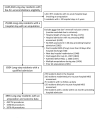Impact of amputation level and comorbidities on functional status of nursing home residents after lower extremity amputation
- PMID: 24406089
- PMCID: PMC4004653
- DOI: 10.1016/j.jvs.2013.11.076
Impact of amputation level and comorbidities on functional status of nursing home residents after lower extremity amputation
Abstract
Objective: The ability of nursing home residents to function independently is associated with their quality of life. The impact of amputations on functional status in this population remains unclear. This analysis evaluated the effect of amputations-transmetatarsal (TM), below-knee (BK), and above-knee (AK)--on the ability of residents to perform self-care activities.
Methods: Medicare inpatient claims were linked with nursing home assessment data to identify admissions for amputation. The Minimum Data Set Activities of Daily Living Long Form Score (0-28; higher numbers indicating greater impairment), based on seven activities of daily living, was calculated before and after amputation. Hierarchical modeling determined the effect of the surgery on postamputation function of residents. Controlling for comorbidity, cognition, and prehospital function allowed for evaluation of Activities of Daily Living trajectories over time.
Results: In total, 4965 residents underwent amputation: 490 TM, 1596 BK, and 2879 AK. Mean age was 81 years, and 54% of the patients were women. Most were white (67%) or black (26.5%). Comorbidities before amputation included diabetes mellitus (70.7%), coronary heart disease (57.1%), chronic kidney disease (53.6%), and/or congestive heart failure (52.1%). Mortality within 30 days of hospital discharge was 9.0%, and hospital readmission was 27.7%. Stroke, end-stage renal disease, and poor baseline cognitive function were associated with the poorest functional outcome after amputation. Compared with residents who received TM amputation, those who had BK or AK amputation recovered more slowly and failed to return to baseline function by 6 months. BK was found to have a superior functional trajectory compared with AK.
Conclusions: Elderly nursing home residents undergoing BK or AK amputation failed to return to their functional baseline within 6 months. Among frail elderly nursing home residents, higher amputation level, stroke, end-stage renal disease, poor baseline cognitive scores, and female sex were associated with inferior functional status after amputation. These factors should be strongly assessed to maintain activities of daily living and quality of life in the nursing home population.
Copyright © 2014 Society for Vascular Surgery. Published by Mosby, Inc. All rights reserved.
Figures




References
-
- Gillen P, Spore D, Mor V, Freiberger W. Functional and residential status transitions among nursing home residents. J Gerontol A Biol Sci Med Sci. 1996;51(1):M29–36. - PubMed
-
- Mehr DR, Binder EF, Kruse RL, Zweig SC, Madsen R, Popejoy L, et al. Predicting mortality in nursing home residents with lower respiratory tract infection: The Missouri LRI Study. JAMA. 2001;286(19):2427–36. - PubMed
-
- Manton KG. A longitudinal study of functional change and mortality in the United States. J Gerontol. 1988;43(5):S153–61. - PubMed
-
- Rantz MJ, Popejoy L, Zwygart-Stauffacher M, Wipke-Tevis D, Grando VT. Minimum Data Set and Resident Assessment Instrument. Can using standardized assessment improve clinical practice and outcomes of care? J Gerontol Nurs. 1999;25(6):35–43. quiz 54-5. - PubMed
-
- Morris JN, Fries BE, Morris SA. Scaling ADLs within the MDS. J Gerontol A Biol Sci Med Sci. 1999;54(11):M546–53. - PubMed
Publication types
MeSH terms
Grants and funding
LinkOut - more resources
Full Text Sources
Other Literature Sources
Medical

